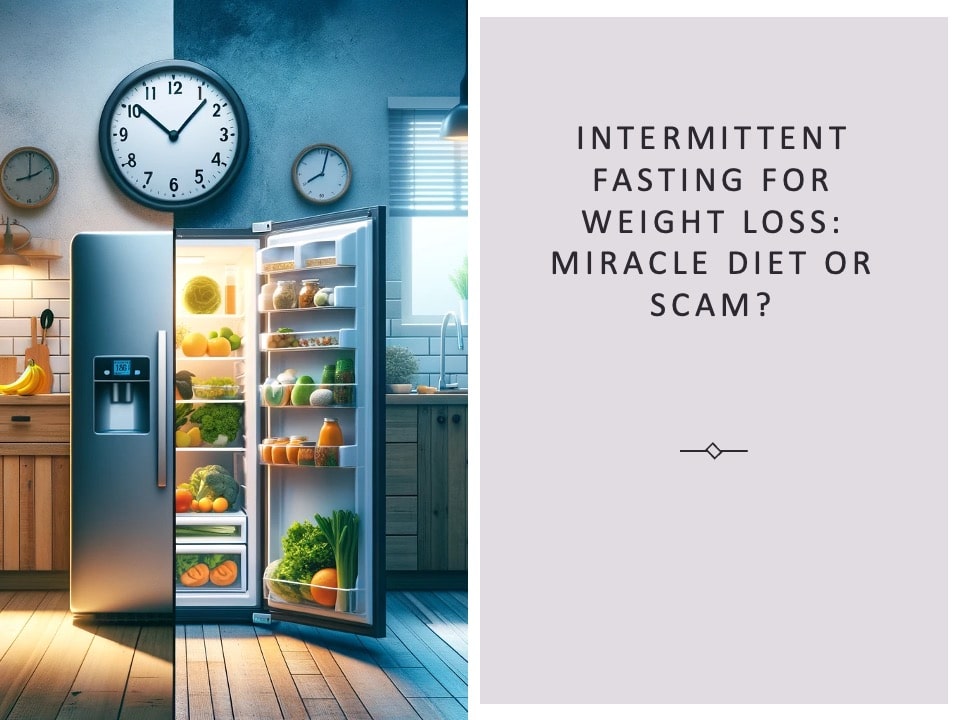Intermittent Fasting for Weight Loss: Miracle Diet or Scam?
Intermittent fasting for weight loss has become one of the most researched and widely discussed approaches to sustainable dieting in recent years.
Instead of restricting specific foods, intermittent fasting focuses on when you eat, creating structured periods of fasting and eating that encourage the body to switch from burning glucose to burning stored fat for energy.
Unlike many fad diets, this time-restricted eating style is supported by clinical evidence.
Research shows that intermittent fasting not only helps reduce body weight but also improves key health markers, including insulin sensitivity, lipid profiles, and even cognitive function (Harvie et al., 2011; Varady, 2011).
These benefits make IF a lifestyle approach rather than just a quick fix.
Its growing popularity stems from its flexibility.
Whether through the 16/8 method, the 5:2 diet, or alternate-day fasting, individuals can adapt IF to their schedules without obsessively counting calories.
For many, this creates a healthier and more sustainable relationship with food compared to traditional calorie-restricted diets.
As evidence and success stories continue to mount, more people are exploring intermittent fasting as a practical way to improve both health and body composition.
With its adaptability, science-backed benefits, and simplicity, intermittent fasting for weight loss is a long-term strategy for healthier living.
What is Intermittent Fasting?

Intermittent Fasting (IF) is a dietary approach that alternates between periods of eating and fasting.
Unlike traditional diets, IF doesn’t prescribe specific foods but rather focuses on when you should eat.
During fasting periods, your body, deprived of its usual energy source from food, starts to burn stored fats for energy.
This switch in energy sources can lead to weight loss and other health benefits.
Eating windows, on the other hand, are the designated times when you consume your meals, providing your body with energy and nutrients before the next fasting period.
Lastly, this approach comes in various forms, each designed to fit different lifestyles and goals.
Why is Intermittent Fasting Good for Weight Loss?
Intermittent Fasting for weight loss works by shifting the focus from what you eat to when you eat, making it a simple yet powerful tool for reducing body fat.
By cycling between periods of fasting and eating, the body naturally lowers insulin levels, taps into stored fat for energy, and promotes a more efficient metabolism.
Unlike traditional calorie-restricted diets that often feel rigid or unsustainable, intermittent fasting is highly adaptable.
Its flexible structure allows individuals to choose a fasting schedule that fits seamlessly with their lifestyle, preferences, and long-term health goals.
This combination of metabolic benefits and personalization is what makes intermittent fasting one of the most effective strategies for lasting weight management.
Here is more information on the benefits of intermittent fasting for weight loss:
Personalization to Lifestyle
Different IF schedules can be tailored to individual daily routines and preferences.
For example, some might find it easier to skip breakfast and opt for the 16/8 method, while others might prefer the 5:2 diet due to its less frequent fasting requirements.
Psychological and Behavioral Factors
IF can be psychologically more appealing and easier to adhere to than traditional calorie-restricted diets.
The simplicity of the rules (focusing on ‘when’ rather than ‘what’ to eat) can make it easier for individuals to stick with the program long-term.
Metabolic Flexibility
IF promotes metabolic flexibility, training the body to efficiently switch between using carbohydrates and fats as its primary energy source.
This adaptability can lead to improved fat-burning and energy utilization, which is beneficial for weight management.
Variability in Health Benefits
Different IF methods may offer unique health benefits.
For instance, shorter fasting periods (like in the 16/8 method) might be more focused on weight management and improved metabolic health, while longer fasts (like in the Eat-Stop-Eat method) could potentially offer deeper cellular and hormonal benefits.
Adaptation Over Time
Individuals can start with a less stringent form of IF and gradually adapt to more intensive fasting schedules as their bodies and lifestyles adjust, allowing for a customized approach to health and wellness.
Most Popular Forms of Intermittent Fasting
16/8 Method
One of the most popular forms, this method involves fasting for 16 hours each day and eating all meals within an 8-hour window (Gabel et al., 2018).
For example, you might eat between 12 pm and 8 pm and fast for the remaining hours.
Think of it as a daily mini-vacation for your digestive system.
For 16 hours, you fast. For the remaining 8, you feast.
Picture this: your day starts at noon with a hearty lunch and winds down with an 8 pm dinner, turning the rest of your hours into a fat-burning fiesta.
With this form of intermittent fasting, you can also combine intermittent fasting and carb backloading for some especially unique results.
5:2 Diet
This involves eating normally for five days of the week and then limiting calorie intake to about 500-600 calories on the remaining two days.
These two fasting days should not be consecutive.
The 5:2 intermittent fasting diet is a total weekly twist – five days of normal eating, interspersed with two days of minimalist calorie intake (think 500-600 calories).
It’s like giving your body a periodic reset button!
Eat-Stop-Eat
This method of intermittent fasting involves a full 24-hour fast once or twice a week.
During fasting days, no food is consumed, and on non-fasting days, you eat normally.
For the bold and the disciplined, this involves a full 24-hour fast once or twice a week.
It’s a clean break, a total system reboot that challenges and reshapes your relationship with food.
Can You Eat or Drink Anything During Intermittent Fasting?
During the fasting periods of intermittent fasting, the general guideline is to avoid consuming any food or beverages that contain calories.
However, you can consume certain zero- or low-calorie beverages and items that don’t significantly impact the fasting process.
Here’s a list of what you can typically consume during fasting periods:
- Water: Plain water doesn’t contain calories and is essential for staying hydrated. You can drink still or sparkling water.
- Black Coffee: Coffee without any added sugar, milk, or cream is usually considered acceptable. It contains very few calories and can help suppress appetite.
- Tea: Similar to coffee, plain tea (black, green, herbal) without any sweeteners or milk can be consumed.
- Apple Cider Vinegar: A small amount of apple cider vinegar diluted in water is often allowed as it contains minimal calories.
- Zero-Calorie Drinks: Some zero-calorie drinks might be permissible, but it’s important to check for any artificial sweeteners or additives that could affect blood sugar levels or induce an insulin response.
- Bone Broth: While it does contain some calories, bone broth is sometimes used during fasting periods for its nutrients and electrolytes. However, purists might argue that it breaks the fast.
It’s important to note that the impact of these beverages can vary from person to person.
While they generally do not break a fast for most people, individual responses can differ, particularly in terms of insulin response and how it might affect the overall goals of fasting.
For anyone serious about intermittent fasting, it’s advisable to stick to water, black coffee, and tea during fasting periods to ensure the effectiveness of the fast.
If you have specific health concerns or dietary needs, it’s always best to consult with a healthcare professional.
What to Eat During “Fed” Periods?
To promote weight loss and overall health during the eating periods of intermittent fasting (IF), it’s important to focus on nutrient-dense foods that provide essential vitamins, minerals, and other nutrients.
Here are some key dietary guidelines:
- Lean Proteins: Include lean meats, poultry, fish, eggs, and plant-based protein sources like beans, lentils, and tofu. Proteins are essential for muscle repair and growth, and they help keep you feeling full longer.
- Healthy Fats: Incorporate sources of healthy dietary fats such as avocados, nuts, seeds, olive oil, and fatty fish like salmon. These fats are crucial for brain health and satiety.
- Whole Grains: Opt for whole grains like quinoa, brown rice, barley, and whole grain bread. They provide fiber, which aids in digestion and helps maintain steady blood sugar levels.
- Fruits and Vegetables: Consume a variety of fruits and vegetables. They are rich in vitamins, minerals, and antioxidants, and low in calories, making them ideal for weight loss.
- Dairy or Dairy Alternatives: Include low-fat dairy or plant-based alternatives fortified with calcium and vitamin D.
- Hydration: Stay hydrated with water, herbal teas, or other low-calorie beverages.
- Limit Processed Foods and Sugars: Reduce intake of processed foods, sugary snacks, and beverages. These are high in calories and low in nutrients and can hinder weight loss efforts.
- Portion Control: Be mindful of portion sizes to avoid overeating, even with healthy foods.
Remember, while IF focuses on when you eat, what you eat is equally important for weight loss and overall health.
It’s essential to maintain a balanced diet during eating periods to ensure your body gets the necessary nutrients.
Additionally, consider consulting with a healthcare provider or a dietitian for personalized dietary advice, especially if you have specific health conditions or dietary restrictions.
Health Benefits of Intermittent Fasting
Intermittent Fasting (IF) has gained popularity as a weight loss method due to its unique approach and the variety of benefits it offers, which extend beyond simple calorie restriction.
Here are a few of the health benefits of intermittent fasting:
Targeted Fat Loss and Improved Metabolic Health
One of the key advantages of IF is its ability to target waist circumference and central fat distribution, crucial factors in reducing cardio-metabolic risks (Morales-Suarez-Varela et al., 2021).
This targeted fat loss is particularly significant as central obesity is closely linked with various health issues.
Enhanced Cholesterol Profile
IF has been associated with an increase in HDL-cholesterol particles.
HDL, often referred to as “good cholesterol,” plays a vital role in heart health, and its increase is a positive sign of improved metabolic health.
Alteration in Gut Microbiota
The modification of gut microbiota through IF, particularly the enrichment of beneficial bacterial families like Bacteroidaceae, Lactobacillaceae, and Prevotellaceae, contributes to overall health and potentially aids in weight loss.
Metabolic Benefits Independent of Weight Loss
IF can improve health indicators even without significant weight loss.
This is attributed to unique signaling pathways and changes in metabolic patterns, potentially influenced by alterations in eating and sleeping cycles (Aksungar et al., 2007).
Fasting-Induced Hormonal and Insulin Changes
Fasting significantly reduces insulin levels, which in turn facilitates fat burning.
Lower insulin levels during fasting periods enhance the body’s ability to utilize fat stores for energy.
This reduction in insulin can be up to 20-30%, offering benefits for those at risk of type II diabetes.
Preservation of Muscle Mass
Contrary to common misconceptions, IF can preserve muscle mass.
During fasting, the body first utilizes fat for energy and only resorts to protein (muscle) breakdown after extended periods of fasting.
This aspect is critical for individuals concerned about losing muscle mass while dieting.
Increased Human Growth Hormone (HGH) Production
Fasting can naturally increase the production of HGH, a hormone that supports muscle growth and overall physical well-being.
Synergy with Exercise
When combined with resistance training, IF can be more effective in reducing body fat and preserving fat-free mass compared to non-fasting diets (Shojaie., 2017).
Side Effects of Intermittent Fasting for Weight Loss
While IF has many benefits, it’s important to approach it cautiously, especially for normal-weight individuals or those with a history of eating disorders.
Mood disturbances and binge eating are potential risks that should not be overlooked (Harvie & Howell, 2017).
Final Thoughts: Should You Try Intermittent Fasting for Weight Loss?
Intermittent fasting for weight loss is a sustainable approach that reshapes how your body uses energy and how you think about food.
By lowering insulin levels, improving fat metabolism, and supporting overall health, IF offers benefits that extend beyond weight loss alone.
Still, it isn’t a one-size-fits-all solution. Some people thrive with time-restricted eating, while others may find fasting schedules difficult to maintain or unsuitable due to health conditions.
Starting gradually, choosing a method that aligns with your lifestyle, and seeking guidance from a healthcare professional can make all the difference in long-term success.
When practiced mindfully, intermittent fasting can be a powerful tool for improving both health and body composition.
For those searching for a balanced, flexible, and evidence-backed strategy, Intermittent fasting for weight loss can be an effective and lasting solution.
This website does not provide medical advice. This website site does contain affiliate links, and purchases may earn a commission.
Read my Medical Disclaimer, Review Disclaimer, and Publishing Policies for more details. Use of this site indicates acceptance of these terms.



